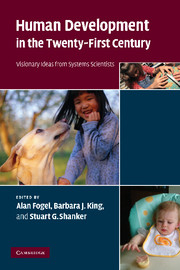Book contents
- Frontmatter
- Contents
- List of contributors
- Introduction: Why a dynamic systems approach to fostering human development?
- Part I Dynamic relationships between genetics and environments
- Part II The dynamic system of the child in the family
- Part III The dynamic system of the child in social and physical environment
- Part IV Dynamic systems approaches to mental health
- 17 A dynamic developmental model of mental health and mental illness
- 18 Dyadic microanalysis of mother–infant communication informs clinical practice
- 19 Current problems of Japanese youth: some possible pathways for alleviating these problems from the perspective of dynamic systems theory
- 20 A different way to help
- 21 Why do siblings often turn out very differently?
- 22 A dynamic systems approach to understanding family and peer relationships: implications for effective interventions with aggressive youth
- 23 Prenatal substance exposure and human development
- Part V Conclusions and outlook
- Index
- References
23 - Prenatal substance exposure and human development
Published online by Cambridge University Press: 22 September 2009
- Frontmatter
- Contents
- List of contributors
- Introduction: Why a dynamic systems approach to fostering human development?
- Part I Dynamic relationships between genetics and environments
- Part II The dynamic system of the child in the family
- Part III The dynamic system of the child in social and physical environment
- Part IV Dynamic systems approaches to mental health
- 17 A dynamic developmental model of mental health and mental illness
- 18 Dyadic microanalysis of mother–infant communication informs clinical practice
- 19 Current problems of Japanese youth: some possible pathways for alleviating these problems from the perspective of dynamic systems theory
- 20 A different way to help
- 21 Why do siblings often turn out very differently?
- 22 A dynamic systems approach to understanding family and peer relationships: implications for effective interventions with aggressive youth
- 23 Prenatal substance exposure and human development
- Part V Conclusions and outlook
- Index
- References
Summary
Robert was small and slightly underweight at birth. He had been exposed to drugs while his mother was pregnant. His cries sometimes sounded high-pitched, and he was often tense and rigid. Robert's mother moved twice before he was two years old. First she moved in with her mother; then she moved out again. Robert was not quite as quick as other children at learning new words. He was not good at sorting blocks and learning to pick up beads. Robert had a new sister, a half-sister, when he was three. There were not many books or magazines at home. When Robert began kindergarten, he had trouble learning the letters. Sometimes, he seemed a little tuned out and apathetic.
Neighborhood poverty and family disorganization contributed to Robert's delayed developmental course – as did the prenatal insult of Robert's mother's substance abuse. In our society, prenatal drug exposure is a major public health problem. Many drugs used during pregnancy travel freely through the umbilical cord and cross the fetal blood–brain barrier. What kind of effect would such drugs have on Robert's development? A developmental systems model suggests that the interplay of many factors influenced Robert's development. The impact of drugs on the fetus during the pregnancy depends on the timing of use, dosage, level of prenatal nutrition, and individual differences among mothers, some of which may be heritable. The impact of maternal drug abuse on subsequent child development is even more complex and multidetermined.
- Type
- Chapter
- Information
- Human Development in the Twenty-First CenturyVisionary Ideas from Systems Scientists, pp. 225 - 232Publisher: Cambridge University PressPrint publication year: 2007



